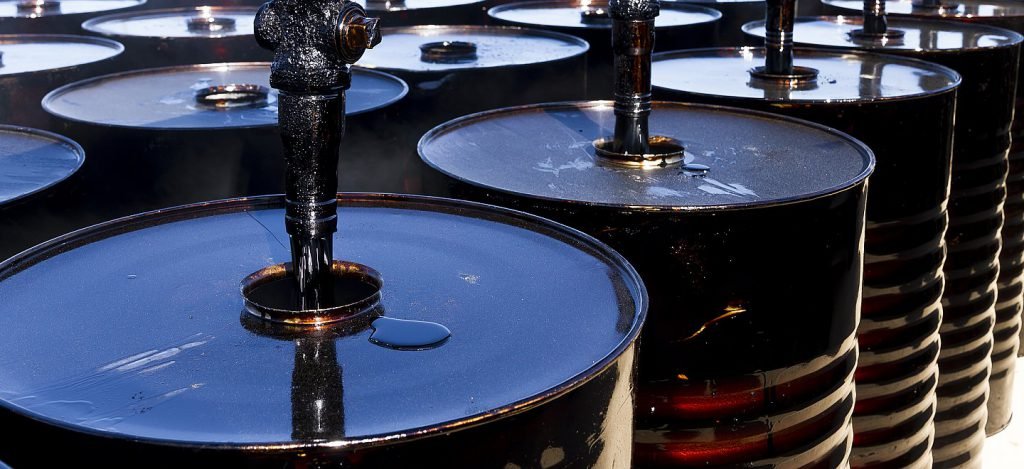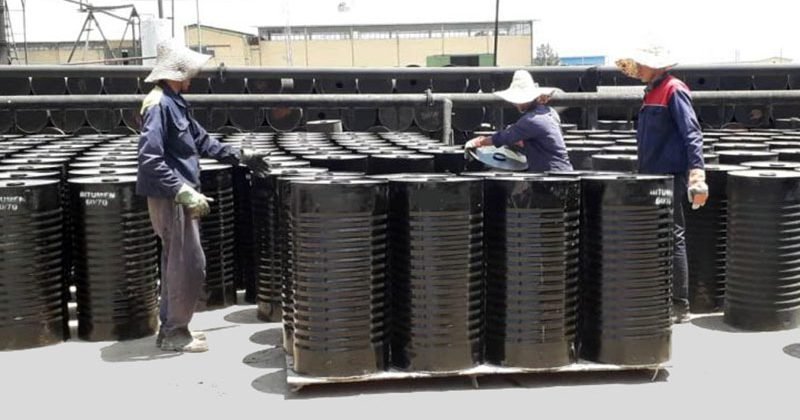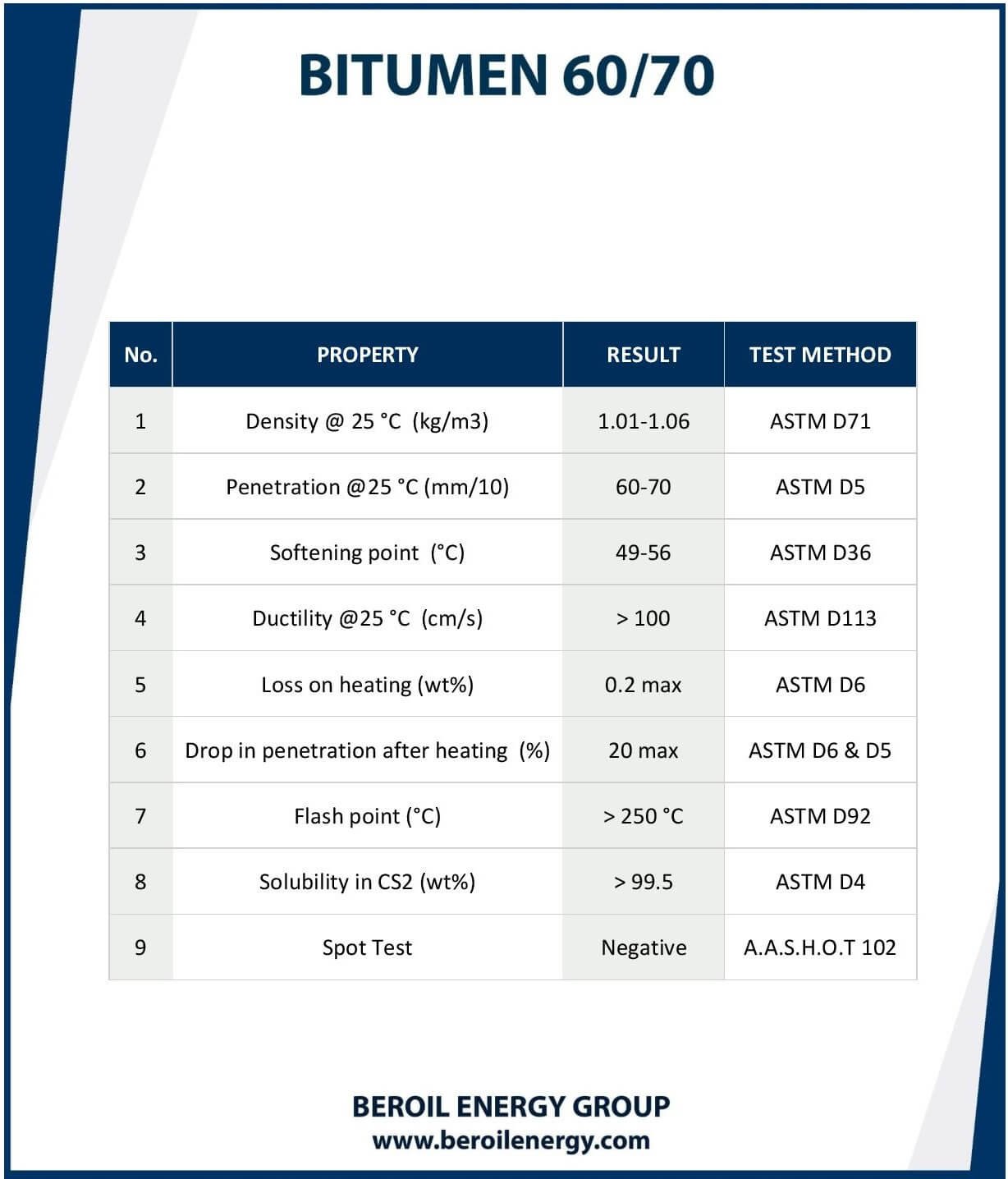

Bitumen, also known as asphalt in the United States, is a mixture of dense, sticky, viscous organic liquids, mainly composed of polycyclic aromatic hydrocarbons, naturally occurring or obtained through the distillation of crude oil. It is black or brown in colour and possesses waterproofing and adhesive properties.
Naturally occurring or crude bitumen is a sticky, tar like form of petroleum which is so thick and heavy that it must be heated or diluted before it will flow. At room temperature, it is much like cold molasses. Naturally-occurring bitumen, sometimes also called natural asphalt, rock asphalt or oil sand, has been used as an adhesive, sealant and waterproofing agent for over 8,000 years. But it occurs only in small quantities and its properties are quite different from refined bitumen.
Refined Bitumen is obtained as the last residue in fractional distillation of crude petroleum. Crude petroleum is a mixture of hydrocarbons of different molecular weights. In the petroleum refineries the individual components like LPG, naphtha, Kerosene, Diesel etc. are separated through the process of fractional distillation. The heaviest material obtained from the fractional distillation process is further treated and blended to make different grades of paving grade bitumen. The grade of the bitumen depends on how much volatile material remains in the distilled bitumen—with more volatiles resulting in a less pure, more liquid product.
Currently most of the roads globally are paved with bitumen. Today the world’s demand for bitumen accounts for more than 100 million tons per year which is approximately 700 million barrels of bitumen consumed annually.
In different regions and countries, different Standards and Grading systems are used for determining the quality of petroleum bituminous Binders. The most recognized standards for petroleum bitumen are published by:
The bitumen type varies based on their origin as well as a method of refining. Generally the bitumen grades which are known and produced worldwide are as follows:
The penetration grading system was developed in the early 1900s to characterize the consistency of semi-solid asphalts. The penetration grade bitumen is refinery bitumen that is manufactured at different viscosities and is a standard bitumen usually used as a Paving Grade Bitumen essential for road construction and for the production of asphalt pavements with superior properties. The penetration test is carried out to characterize the bitumen, based on the hardness. Thus, it has the name penetration bitumen.
Penetration grading’s basic assumption is that the less viscous the asphalt, the deeper the needle will penetrate. Bitumen which is produced during the process of oxidation of vacuum bottom (the Bitumen production feedstock that derives from distillation tower residue in vacuum oil refineries) at bitumen production unit will be classified based on its penetration point. Penetration grades are listed as a range of penetration units (one penetration unit = 0.1 mm) such as 60/70. Grading of bitumen helps to assess its suitability in different climatic conditions and types of construction. In warmer regions, lower penetration grades are preferred to avoid softening whereas higher penetration grades like 120/150 are used in colder regions to prevent the occurrence of excessive brittleness. Penetration grades specified in AASHTO M 20 and ASTM D 946 are listed in the below table.
| Penetration Grade | Description |
| 30/40 | Hardest grade |
| 40/ 50 | Semi-hard penetration grade |
| 60/70 | Typical grades used worldwide |
| 80/100 | Semi-soft penetration grade |
| 120/150 | Soft penetration grade |
| 200/300 | Softest grade. Used for cold climates such as northern Canada |
• Bitumen 80/100: The characteristics of this grade confirm to that of S 90 grade of IS-73-1992. This is suitable for low volume roads and is still widely used worldwide. Due to its relatively low air blowing and penetration point, it is used in cold areas.
• Bitumen 60/70: This grade is harder than 80/100 and can withstand higher traffic loads. The characteristics of this grade confirm to that of S 65 grade of IS-73-1992. Bitumen 60/70, means penetration is between 60 dm (Decimeter) to 70 dm, that’s mean needle will penetrate to bitumen sample minimum 60 dm and maximum 70 dm. It is presently used mainly in the construction of Highways. Bitumen 60/70 is one of the most used bitumen grades and it’s a basic material for all other bituminous products. It is used in mild areas.
• Bitumen 40/50: Bitumen penetration grade 40/50 means the penetration value is in the range 40 to 50 at standard test conditions which commonly used as a Paving Grade. Bitumen penetration grade 40/50 is semi-hard penetration grade bitumen suitable for road construction and repair. This grade of bitumen is mainly used in the manufacturing of hot mix asphalt for bases and wearing courses.
• Bitumen 30/40: This is the hardest of all the grades and can withstand very heavy traffic loads. The characteristics of this grade confirm to that of S 35 grade of IS-73-1992. Bitumen 30/40 is used in specialized applications like airport runways and also in very heavy traffic volume roads in coastal cities.
Cutback is a free-flowing liquid at normal temperatures and is obtained by fluxing bitumen with suitable solvents. The viscosity of bitumen is reduced substantially by adding kerosene or any other solvent. Cutback Bitumen is made by reducing the viscosity of and ordinary bitumen by adding mostly petroleum type solvent. For use in surface dressings, some type of bitumen macadam and soil-bitumen stabilization, it is necessary to have a fluid binder which can be mixed relatively at low temperatures. Hence to increase the fluidity of the bituminous binder at low temperatures the binder is blended with a volatile solvent. After the cutback mix is used in construction work, the volatile gets evaporated and the cutback develops the binding properties. The viscosity of cutback and rate of which it hardens on the road depend on the characteristics and quantity of both bitumen and volatile oil used as the diluents. Cutback Bitumen is used because its viscosity is lower than that of neat asphalt and can thus be used in low-temperature applications. Cutback bitumen can be used for cold weather bituminous road construction and maintenance.
Cutbacks are classified according to the time it takes for them to cure, or become solid due to the evaporation of the diluent. Classifications are rapid curing (RC), medium curing (MC) or slow curing (SC). A cutback varies in behavior according to the type of cutter or flux used as the diluent with white spirit commonly used for RC grades, kerosene for MC and diesel for SC. A rapid-curing (RC) solvent will evaporate more quickly than a medium-curing (MC) solvent, which in turn will cure more rapidly than a slow-curing (SC) solvent.
Cutback bitumen standards are as follow:
– ASTM D 2026, D 2027 and D 2028 for Slow, Medium and Rapid Curing Cutback
– AASHTO M 81, M 82 for Rapid and Medium Curing Cutback
– EN 15522 Cutback and Fluxed Bituminous Binder
Cutback Bitumen generally are divided into three groups depending on their volatility of the solvent added:
• Slow Curing (SC-30, SC-70, SC-250, SC-800, SC-3000), often called “road oils,” are usually a residual material produced from the fractional distillation of certain crude petroleums. Traditionally any kind of aromatic, naphthenic and paraffinic oils are used. Slow Curing liquid bitumen materials can be prepared by blending bitumen with an oily petroleum fraction.
• Medium Curing (MC-70, MC-250, MC-800, MC-3000), are a blend of Bitumen with lighter hydrocarbons such as kerosene.
• Rapid Curing (RC-30, RC-70, RC-250, RC-800, RC-3000), are prepared with a light, rapidly evaporating diluent such as naphtha or gasoline.
In the early 1960s, an improved bitumen (asphalt) grading system was developed that incorporated a rational scientific viscosity test. This scientific test replaced the empirical penetration test as the key bitumen binder characterization. Viscosity grading quantifies the following bitumen characteristics:
– Viscosity at 60°C (140°F)
– Viscosity at 135°C (275°F)
– The penetration depth of a 100 g needle applied for 5 seconds at 25° C (77° F)
– Flashpoint temperature
– Ductility at 25°C (77°F)
– Solubility in trichloroethylene
– Thin-film oven test (accounts for the effects of short-term aging):
– Viscosity at 60° C (140° F)
– Ductility at 25° C (77° F)
Viscosity grades Bitumen are categorized according to Viscosity (degree of fluidity) grading. The higher the grade, the stiffer the Bitumen. In Viscosity Grade, Viscosity tests are conducted at 60°C and 135°C, which represents the temperature of road surface during summer and mixing temperature respectively. The penetration at 25°C, which is annual average pavement temperature, has been also retained in Specifications.
Viscosity Grade bitumen standards are as follow:
– AASHTO M 226
– ASTM D 3381
– IS73:2013
The new grades based on S73:2013 standard have thus evolved with the nomenclature:
| Grades | Minimum of Absolute viscosity, Poise@ 60°C | Approximate penetration grade |
| VG 10 | 800 | 80-100 |
| VG 20 | 1600 | —- |
| VG 30 | 2400 | 60-70 |
| VG 40 | 3200 | 30-40/40-50 |
VG-10 BITUMEN: VG-10 is mostly used in spraying applications such as surface dressing and Paving in a very cold climate instead of 80/100 penetration bitumen grade. It is also used to produce Bitumen Emulsion and Modified Bitumen products.
VG-20 BITUMEN: VG-20 is used for paving in cold climate & high altitude regions.
VG-30 BITUMEN: VG-30 is especially used to construct extra heavy duty Bitumen pavements that need to tolerate significant traffic loads. It can be used instead of a 60/70 penetration bitumen grade.
VG-40 BITUMEN: VG-40 is used in highly stressed areas such as intersections, near toll booths and truck parking lots instead of 30/40 penetration grade. Because of higher viscosity, stiffer Bitumen mixes can be produced to amend resistance to shoving and other problems related to a higher temperature and heavy traffic loads.
Bitumen emulsion is a free flowing liquid at ambient temperatures and is consisting of two immiscible liquids, bitumen and water, stabilized by a third component, the emulsifier. The bitumen is dispersed throughout the continuous aqueous phase in the form of discrete droplets, typically 0.5 to 5 microns in diameter, which are held in suspension by electrostatic charges. Dispersion is obtained by processing bitumen and water under controlled conditions through a colloidal mill together with selected additives.
The bitumen content can be varied to suit different requirements and is typically between 30% and 70%. The primary objective of emulsifying bitumen is to obtain a product that can be used without the heating normally required when using cutbacks and paving grade bitumen. The use of proper quality emulsifiers is essential to ensure that the emulsion has stability over time and also that it breaks and sets when applied on aggregates/road surface. It is chocolate brown free flowing liquid at room temperature.
Bitumen Emulsions need to be classified by their ionic charge into cationic or anionic. Since water bitumen emulsions are used intensively as binding and film-forming material in construction, two types of emulsifiers are used: anionic and cationic. Anionic bitumen emulsions are generally not used in road construction as generally siliceous aggregate is used in road construction. Anionic bitumen emulsions do not give good performance with siliceous whereas cationic bitumen emulsions give good performance with these aggregates.
Cationic emulsions coat the aggregates more efficiently due to their positive load and have therefore better adhesion properties. Cationic Emulsion is both more favored and more widely used. Cationic emulsions begin with a “C” If there is no C, the emulsion is usually an anionic. The charge is important when designing an emulsion for compatibility with certain aggregates. The next set of the specification describes how quickly an emulsion will set or coalesce. RS (Rapid Set), MS (Medium Set), SS (Slow Set), and QS (Quick Set) are the setting-grades.
Bitumen emulsions have a low viscosity and can be workable at ambient temperatures, which makes them ideal for use in road pavements and surfacing.
Emulsion Bitumen standards are as follow:
– USA Anionic Emulsions: ASTM D 977 and AASHTO M 140
– USA Cationic Emulsions: ASTM D 2397 and AASHTO M 208
– Europe: Harmonized Framework Standard EN 13808
The main grades for bitumen emulsions are classified as follows:
| Anionic Emulsion Code | Cationic Emulsion Code | Setting Type |
| ARS | CRS | Rapid Setting |
| AMS | CMS | Medium Setting |
| ASS | CSS | Slow Setting |
Bitumen Emulsion CSS-1: CSS-1 is a cationic slow setting bitumen emulsion designed for use as a tack coat, base stabilization, fog sealing, dust control and specialty applications. Cationic bitumen emulsions CSS-1 have a positive charge and hence a direct and very rapid reaction between the emulsion and an aggregate or pavement is possible. CSS-1 emulsions are used for a variety of purposes. Slow setting emulsions are the most stable of emulsions, and generally can be diluted with water and mixed with mineral fillers and aggregates For all uses, the air and pavement temperatures at construction should be sufficiently high to allow the emulsion to fully cure.
Bitumen Emulsion CMS-2: CMS-2 is a medium setting cationic water-based asphalt emulsion for use in cold and warm asphalt and aggregate mixtures, base stabilization, and full depth reclamation. CMS-2 can be mixed cold or warm at a central plant, with a portable pugmill at the job site or in-place on the roadway. The mixed material may be used immediately, or stockpiled for later use. It may be placed with a paver or worked onto the pavement with a blade or reclaimer.
Bitumen Emulsion CRS-2: CRS-2 is a cationic water-based emulsified asphalt designed for use as a bituminous binder for chip seals. It is supplied in bulk. CRS-2 emulsions should be applied with well-calibrated distributors. The distributor nozzles and spray bar should be sized and set to deliver the desired shot rate. The shot rate should be determined by a laboratory chip seal design with the project aggregate and the conditions of the existing pavement. CRS-2 should not be applied when the air temperature is below 60°F and falling. The water-based emulsion should not be exposed to freezing temperatures or overheating. The emulsion is a chemically stabilized system, so care should be taken not to upset the chemical balance with contamination by chemicals, over-exposure to air, or adverse mechanical or thermal conditions.
The refinery bitumen is further treated by the introduction of processed air. This will give us oxidized bitumen, also known as blown bitumen. In this process, by maintaining a controlled temperature, hot air with a temperature of 200 to 300 degrees Celsius is blown through a perforated tube into a compartment containing bitumen, the air is introduced under pressure into soft bitumen. This process gives the bitumen more rubbery properties than its original formula and they are simply harder bitumen. Blowing air through the bitumen mix gives it higher viscosity and greater resistance to softening (particularly for road applications), and secondary processes involving specially developed additives or emulsifying with water. Large asphalt manufacturers nowadays use these additives in their production to achieve a greater performance for the final result. This harder mix has a lower ductility and temperature susceptibility.
Oxidized bitumen has a higher degree of softness and lower sensitivity to temperature variations. This type of bitumen is used to make roofing sheets, car tires and lining. Oxidized asphalt is typically used in roofing operation, pipe coating, undersealing for Portland cement concrete pavements, hydraulic application and manufacture of paints. Blown grade bitumen is widely used as an anti-slip layer compound in the piling industry, for the manufacture of roofing felts, for sound dampening felts and under carriage sealant in the automobile industry, electric cable joint protection, joint filling compound, sealant compound and many others.
The oxidized bitumen could be packed in a plastic bag, craft bag and also in drum and possible to deliver hot in bulk tanker. Oxidized bitumen (Blown grade bitumen) shall be broken up into small pieces and heated slowly to the application temperature of 220ºC to 230ºC.
Oxidized bitumen Symbolic is R. For example R 80/25 bitumen means blown bitumen with the degree of softness 80 centigrade and a degree of penetration is 25. Oxidized bitumen is produced in various grades including:
• Oxidized Bitumen 150/5
• Oxidized Bitumen 115/15
• Oxidized Bitumen 105/35
• Oxidized Bitumen 95/25
• Oxidized Bitumen 90/40
• Oxidized Bitumen 90/10
• Oxidized Bitumen 90/15
• Oxidized Bitumen 85/25
• Oxidized Bitumen 85/40
• Oxidized Bitumen 85/25
• Oxidized Bitumen 75/25
Usually bitumen is packaged and exported in new steel drums. Drum bitumen capacity ranges from 150 Kg to 200 Kg. The most commonly used drum packaging capacity by nearly all bitumen consumers in the globe is 180 Kg.
180 Kg drums are used more widely by bitumen consumers as they are the most beneficial to them. Bitumen importers can save on costs by using 180 Kg drums. The areas of savings are associated but not limited to, drum production cost, handling and shipping related expenses.
Bitubags and Jumbo Bags can be a cost-efficient alternative for Bitumen drums. Bitubags can be in two types: 1000 kg and 300kg
The 300kg Bitubags contain a two layer cover, which the first tears up and the second burns and melts in the destination tanker (reservior)
The vast majority of bitumen is used by the construction industry, Mainly, it serves its use in paving and roofing applications. 85% of all bitumen is used as a binder in asphalt for roads, runways, parking lots, and foot paths. Gravel and crushed rock are mixed with thick bitumen, holding it together and it is then applied to roadways.
Excellent waterproofing characteristics and thermoplastic behaviour make it ideal for a wide range of applications. At elevated temperatures (typically between 100 and 2008C) it acts like a viscous liquid and can be mixed with other components and manipulated and formed as required. Once cooled, it is an inert solid that is durable and hydrophobic (repels water).
10% of the bitumen used worldwide is used in the roofing industry as its waterproofing qualities help make roofs function well. 5% of bitumen is used for sealing and insulating purposes in various building materials such as carpet tile backing and paint.
In addition to these main uses, bitumen also has many minor uses. Other examples are soundproofing, explosives, mildew protection, a binder in briquettes, a backing to mirrors, shoe soles, fence post coating and soil stabilization.

We supply the highest quality bitumen with different grades, such as Penetration Bitumen, Viscosity Grade, Cutback Bitumen, Emulsion Bitumen and Oxidized Bitumen to Asia, Africa and Europe at a competitive price.

Our bitumen product is packed in new 180 kg or 150 kg steel drums based on the buyer’s request. Drums have high durability, strength and are built from thick steel sheets by advanced production lines.

We are specialized in bitumen warehousing and shipment by different means of transport. We can ship bitumen packed in drum to all over the world by road transport or by containers through the sea.
Our group of companies is offering bitumen, produced by the highest quality VB and based on international standards. We can supply different grades of bitumen with a competitive price and 100% L/C at sight payment.
Packaging : 180 kg and 150 kg New Drum
Payment terms : T/T – L/C
Delivery Terms: FOB, CPT, CFR ASWP
Min order : 100 MT

Packaging : 180 kg and 150 kg New Drum
Payment terms : T/T – L/C
Delivery Terms: FOB, CPT, CFR ASWP
Min order : 100 MT

Packaging : 180 kg and 150 kg New Drum
Payment terms : T/T – L/C
Delivery Terms: FOB, CPT, CFR ASWP
Min order : 100 MT

Do you need a quotation on this product ?
Beroil Energy
Typically replies within minutes
Do you have any inquiries or questions? Chat with our sales agents on Whatsapp
WhatsApp Us
🟢 Online | Privacy policy
